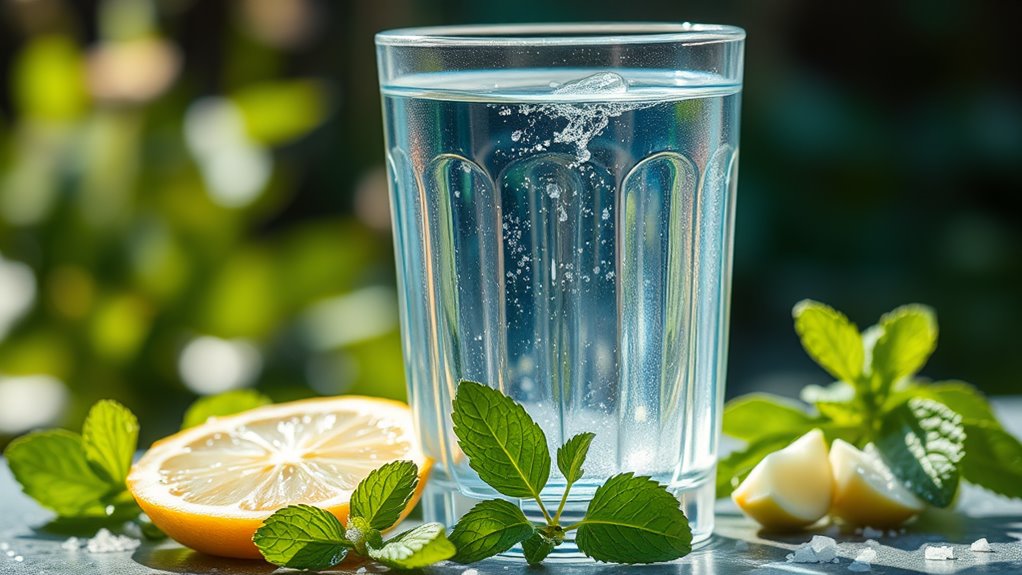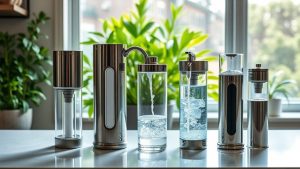
The taste of water varies due to factors like mineral composition, pH levels, purification processes, source, and infrastructure. High calcium and magnesium can create a harder taste, while pH shifts influence flavor perception. Chlorine and fluoride from purification methods may alter taste profiles, too. Additionally, the origin of the water—like well or spring—affects flavor. Pipes, especially in older systems, can leach metals, impacting safety and taste. There's much more to uncover about these regional nuances.
When you take a sip of water, you mightn't realize that its taste is influenced by a variety of factors, including mineral content, pH levels, and purification processes. The mineral composition of water plays a vital role in determining its flavor profile. For instance, high levels of minerals like calcium and magnesium can create a "hard" water experience, imparting a slightly bitter or metallic taste. Regions with distinct geological characteristics yield unique mineral compositions, resulting in diverse drinking water tastes across different areas.
Significantly, elevated magnesium concentrations can additionally enhance bitterness, while sodium can lend a salty flavor when present in significant amounts. While these minerals may alter water's taste, they also provide essential health benefits when consumed in appropriate amounts. Sodium levels that approach 1,000 mg/L can often be detected by taste, which can contribute to the perception of water flavor.
Elevated magnesium levels can enhance bitterness, while sodium contributes a salty flavor, offering health benefits in moderation.
pH levels in water also affect taste, with variations leading to noticeable differences. A more alkaline pH can sometimes yield a sweet aftertaste, particularly when combined with higher calcium levels. The interaction between pH and mineral solubility is essential; as pH shifts, the dissolution of minerals changes, subsequently affecting taste. Natural sources of water exhibit varying pH levels, which can result in inconsistencies in flavor. However, individual sensitivities to small pH changes can differ, meaning not everyone will perceive these variations equally.
Purification processes are another significant factor influencing water's taste. Chlorine disinfection, commonly used in municipal water treatment, often imparts a distinctive chemical flavor. In some cases, areas add fluoride to promote dental health, which can subtly affect taste as well. The extent and type of disinfectants used can vary by region, leading to noticeable differences in flavor.
Activated carbon filters can mitigate unwanted tastes and odors caused by such additives, allowing for a more palatable drinking experience. The refinement of purification processes aims to strike a balance between safety and taste preferences, ensuring that water is both enjoyable and healthy.
The source of your water also contributes to its flavor. For example, well water often contains higher concentrations of metals like iron and copper, imparting a unique taste. In contrast, spring water may have a distinct flavor due to its natural mineral absorption. The geological makeup of the water source influences whether the water is hard or soft, which in turn affects taste.
Additionally, the infrastructure through which water travels can impact its flavor. Older pipe systems may leach metals into the water, compromising both taste and safety. The material of the pipes also plays a role; newer PVC pipes are less likely to impart flavors compared to older metal pipes.
In addition, older systems may foster the growth of algae and bacteria, which can further alter taste. Regular maintenance and upgrades of plumbing systems are essential to ensuring water quality and flavor remain ideal.
Conclusion
To sum up, the taste of water can vary greatly due to factors like mineral content, pH levels, and even the presence of impurities. As the saying goes, "You are what you eat," and in this case, you are what you drink. Understanding these variables not only enhances your appreciation for water but also informs your choices for hydration. By recognizing these nuances, you can select water that best suits your palate and health needs.



